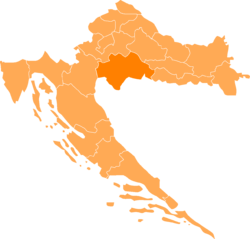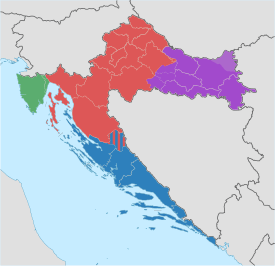Banovina (region)
Banovina, formerly known as Banska krajina or Banija[1] (Serbian Cyrillic: Банија), is a geographical region in central Croatia, between the Sava, Una, and Kupa rivers.[2] The main towns in the region include Petrinja, Glina, Kostajnica, and Dvor. There is no clear geographical border of the region towards the west and the neighboring region of Kordun.[2] The area of Banovina is today administratively almost entirely located within the Sisak-Moslavina County.
Banovina | |
|---|---|
Geographic region of Croatiaa | |
 Collage of Banovina Photos | |
 Banovina on a map of Croatia. Banovina is located in the southern part of Sisak-Moslavina County | |
| Country | |
| Area b | |
| • Total | 4,463 km2 (1,723 sq mi) |
| Population (2001)c | |
| • Total | 183,730 |
| • Density | 41/km2 (110/sq mi) |
| a Banovina is not designated as an official region, it is a geographic region only.
b The figure is an approximation based on the territorial span of Sisak-Moslavina County. c The figure is an approximation based on the population of Sisak-Moslavina County. | |
History
Prehistory
During the era of Chalcolithic Vučedol culture centered in Syrmia and eastern Slavonia spread to the area of modern day Banovina with known archaeological sites being those in Osječenica near the village of Gorička, Budim near the village of Mali Gradac and the Iron Age site next to the Una river in the village of Unčani.[2] During the Iron Age region was inhabited by a Celtic-Illyrians tribe of Segestani.[2]
Classical antiquity
During the Roman time the region was important transitional area between the provinces of Pannonia and Illyricum with nearby Siscia already serving as a regional center.[2] Until today archaeological excavation of Roman sites in the region remain limited.[2]
Middle Ages and Ottoman Conquest
The area surrounding Petrinja and Hrastovica belonged to the Kaptol while the area west of the Glina River belonged to the Topuska Abbey.[2] The Order of Cistercians received the abbey's possessions in 1205 from the Andrew II of Hungary.[2]
Habsburg Monarchy and Austro-Hungarian Empire
After the reconquest of Banija the region became a part of Glina Regiment of Zagreb General Command within the Croatian Military Frontier between 1553 and 1881. In November 1630, Holy Roman EmperorFerdinand II proclaimed the so-called Statuta Valachorum ("Vlach Statute"), which regulated the status of so-called Vlach settlers (in Banovina mostly ancestors of modern-day Serbs of Croatia) with regard to their military obligations and rights to internal self-administration. Croatian Military Frontier existed until 15 July 1881, when it was abolished and incorporated into the Kingdom of Croatia-Slavonia.
Kingdom of Yugoslavia
During the interwar period Banovina was divided between Vrbas Banovina whose seat was in Banja Luka and Sava Banovina whose seat was in Zagreb. In 1939 Sava Banovina became a part of the autonomous Banovina of Croatia.
World War II
During the World War II in Yugoslavia the region was one of the main targets of the Genocide of Serbs in the Independent State of Croatia. One of the most infamous mass killings was the Glina massacres of 2,000–2,400 people. Consequentially, the region also became one of the strongholds of the Yugoslav Partisans, Europe's most effective anti-Axis resistance movement.
Croatian War of Independence
During the Croatian War of Independence in the 1990s the entire region of Banovina became a part of internationally unrecognized self-proclaimed Republic of Serbian Krajina. Croatian government retook control over the region in 1995 via Croatian forces Operation Storm leading to mass fleeing of nearly the entire Serb population of Banija and resulting serious depopulation of the region. Subsequent return was only partial and slow.
See also
References
- Dalibor Brozović, Hrvatska enciklopedija (LZMK), 1. sv. (A – Bd), Leksikografski zavod »Miroslav Krleža«, Zagreb, 1999, str. 600; ISBN 953-6036-29-0
- Škiljan, Filip (2008). Kulturno – historijski spomenici Banije s pregledom povijesti Banije od prapovijesti do 1881 [Cultural and historical monuments of Banija with an overview of history Banija from prehistory to 1881.] (in Serbian). Zagreb, Croatia: Serb National Council. ISBN 978-953-7442-04-0.
External links
- Mrvice s banskoga stola (Essay about names derived from the title Ban, in Croatian)
.jpg)
